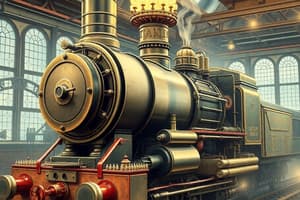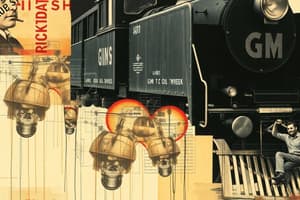Podcast
Questions and Answers
What is one of the primary functions of lubrication in an engine?
What is one of the primary functions of lubrication in an engine?
Which of the following is NOT one of the four systems integrated into the GM locomotive's lube oil system?
Which of the following is NOT one of the four systems integrated into the GM locomotive's lube oil system?
What is the function of the soak back system?
What is the function of the soak back system?
What pressure does the pressure relief valve in the soak back filter assembly open at?
What pressure does the pressure relief valve in the soak back filter assembly open at?
Signup and view all the answers
Which oil pump has the highest discharge rate in the GM locomotive lube oil system?
Which oil pump has the highest discharge rate in the GM locomotive lube oil system?
Signup and view all the answers
What happens to the oil when the pressure builds up to 32 psi in the soak back system?
What happens to the oil when the pressure builds up to 32 psi in the soak back system?
Signup and view all the answers
The bypass valve in the soak back filter assembly opens at what pressure?
The bypass valve in the soak back filter assembly opens at what pressure?
Signup and view all the answers
What is the primary role of the scavenging oil pump?
What is the primary role of the scavenging oil pump?
Signup and view all the answers
What is a crucial factor for the safety and lifespan of an engine according to lubrication needs?
What is a crucial factor for the safety and lifespan of an engine according to lubrication needs?
Signup and view all the answers
How is the main lubricating oil pump and the piston cooling oil pump organized within the GM locomotive's lube oil system?
How is the main lubricating oil pump and the piston cooling oil pump organized within the GM locomotive's lube oil system?
Signup and view all the answers
What is the primary function of the main lubricating oil system?
What is the primary function of the main lubricating oil system?
Signup and view all the answers
At what differential pressure is the by-pass valve for the Michiana oil filter set?
At what differential pressure is the by-pass valve for the Michiana oil filter set?
Signup and view all the answers
What happens in case of insufficient oil pressure?
What happens in case of insufficient oil pressure?
Signup and view all the answers
What is the minimum oil pressure required at idle?
What is the minimum oil pressure required at idle?
Signup and view all the answers
What is delivered by the piston cooling oil pump after it takes oil from the common suction?
What is delivered by the piston cooling oil pump after it takes oil from the common suction?
Signup and view all the answers
What is the function of the relief valve in the main lubricating oil system?
What is the function of the relief valve in the main lubricating oil system?
Signup and view all the answers
Which device operates when the lube oil temperature exceeds 126°c?
Which device operates when the lube oil temperature exceeds 126°c?
Signup and view all the answers
Which part receives lubrication from the main oil manifold?
Which part receives lubrication from the main oil manifold?
Signup and view all the answers
What does the crank-case pressure shutdown switch (CCPS) do?
What does the crank-case pressure shutdown switch (CCPS) do?
Signup and view all the answers
What is the function of the branch pipe lines in the oil distribution system?
What is the function of the branch pipe lines in the oil distribution system?
Signup and view all the answers
Study Notes
GM Locomotive Lube Oil System
- The lube oil system of a GM locomotive is a combination of four separate systems: scavenging, soak back, main lubricating, and piston cooling.
- Each system has its own oil pump.
- The main lubricating oil pump and piston cooling oil pump are in the same housing.
- The scavenging and soak back pumps are separate.
Need for Lubrication
- Necessary for smooth operation of moving parts.
- Cools bearings and pistons to prevent corrosion, rust, damage, and wear.
- Keeps components clean and prevents carbon build-up.
- Ensures the safety of the engine and its components.
- Engine performance and lifespan depend on correct quality, quantity, and pressure of oil, maintained by the lube oil system.
Lube Oil System of GM Locomotive (Components)
- Scavenging system takes oil from the oil sump through a strainer, passes through filters and an oil cooler, then goes to the strainer housing.
- Soak back system provides lubrication for turbocharger bearings before startup and after shutdown, controlled automatically by start/stop controls.
- Main lubricating system supplies lube oil to most moving parts. Oil from the pump goes to the strainer housing, then the main oil manifold above the crankshaft. A relief valve limits the maximum oil pressure.
- Piston cooling oil system takes oil from a common suction with the main lube oil pump and delivers it to piston cooling manifolds, one on each side of the engine. A pipe directs oil to the cylinder underside of each piston crown. Some oil enters the piston pin bearing grooves and drains to the sump.
Pump Discharges (Values)
- Main: 867 LPM (7-8 kg at 8th notch)
- Piston cooling: 413 LPM (5-6 kg at 8th notch)
- Scavenging: 1703 LPM
- Soak back: 11 LPM
Engine Assembly/Operation Information
- Engine Model: RR-520
- Capacity: 1457 liters (or 14571ts)
Soak Back System
- Ensures turbocharger bearings are lubricated before start-up and removes residual heat after engine shutdown.
- A separate pressure source (soak back system) is used.
- The pressure source is automatically controlled by the engine's start/stop controls.
- A pressure relief valve (at 32 psi) returns excess pressure oil to the engine oil pan.
- A bypass valve (at 70 psi) bypasses plugged elements to ensure lubrication to the turbocharger.
Scavenging System (Details)
- The scavenging oil pump is a positive displacement helical gear pump.
- It's mounted on the accessory housing.
- It's driven by the accessory drive gear.
Trouble Shooting
- If the engine has low oil pressure, check oil level and viscosity, and note down oil and water temperatures.
- Check strainer housing and suction leaks. Replace the turbocharger oil filter.
- Inspect the piston pin, and connecting rod for overheating or loose components.
Engine Protection Devices (EPD)
- Crank-Case Pressure Shutdown Switch: When pressure in the crankcase reaches a certain value, the switch operates, draining the governor oil to shut down the engine.
Other Systems and Components
- Low Lube Oil Switch: Shutdowns the engine when lube oil pressure drops below a preset amount.
- Hot Oil Detector (HOD): Shutdowns the engine when lube oil temperature reaches 126°C to protect against engine damage.
- Main Lube Oil Strainer: There are two strainers, each with a replaceable element using a pleated metal core covered with mesh screening.
- Lube Oil Relief Valve: Maintains proper oil pressure.
- Lube Oil Filter Drain Pipe: Drains oil from filters.
- Lube Oil Strainer (Coarse & Fine): Filters oil before entering the engine.
Engine Details
- Minimum Oil Pressure: 8-12 psi at idle, 25-29 psi at full speed.
- Maximum Oil Pressure: Determined by the relief valve setting.
Studying That Suits You
Use AI to generate personalized quizzes and flashcards to suit your learning preferences.
Related Documents
Description
Test your knowledge on the lube oil system of GM locomotives. This quiz covers the various components, their functions, and the importance of lubrication for engine performance and lifespan. Ensure you understand the scavenging, soak back, main lubricating, and piston cooling systems.




